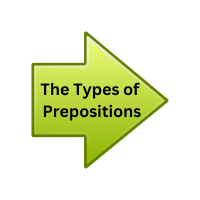The Types of Prepositions

The Types of Prepositions:
Prepositions are words that show the relationship between a noun or pronoun and other words in a sentence. They help indicate location, time, direction, and other relationships. There are three main types of prepositions: simple prepositions, compound prepositions, and phrasal prepositions.
Let’s go through each type with examples:
Simple Prepositions:
Simple prepositions are single words that express the relationship between two elements in a sentence.
Here are some examples:
On: The book is on the table.
In: She lives in the city.
At: We will meet at the park.
Under: The cat is sleeping under the chair.
Over: The birds are flying over the house.
Before: The meeting starts before lunch.
After: We went for a walk after dinner.
Beside: There is a tree beside the lake.
Behind: The car is parked behind the building.
Between: The line connects two points between the cities.
Compound Prepositions:
Compound prepositions are formed by combining two or more words to create a single preposition.
Here are some examples:
Because of: The match was canceled because of the rain.
In front of: The children are playing in front of the school.
On top of: The keys are on top of the table.
Next to: The bank is located next to the post office.
In addition to: In addition to his salary, he gets a bonus.
Phrasal Prepositions:
Phrasal prepositions are groups of words used together as a single preposition.
Here are some examples:
In spite of: In spite of the rain, they went to the beach.
Due to: The event was canceled due to unforeseen circumstances.
As for: As for the dessert, we have cake or ice cream.
According to: According to the weather report, it will rain tomorrow.
On behalf of: She spoke on behalf of the team.
Remember that prepositions always have objects (nouns or pronouns) that follow them in a sentence.
For example, in the sentence The book is on the table, on is the preposition, and the table is its object. The object of the preposition often helps clarify the relationship between the other elements in the sentence.
Prepositional Adverbs:
Prepositions that have the same form as adverbs are called prepositional adverbs or adverbial particles. These are words that can function both as prepositions and as adverbs, depending on their usage in a sentence. They are unique in that they can modify verbs as adverbs do, but they can also take objects like prepositions.
Here are some examples of prepositional adverbs:
Up:
As a preposition: The cat climbed up the tree. (preposition with object the tree)
As an adverb: The cat looked up. (adverb modifying the verb looked)
Down:
As a preposition: She walked down the stairs. (preposition with object the stairs)
As an adverb: The ball rolled down. (adverb modifying the verb rolled)
Around:
As a preposition: They walked around the park. (preposition with object the park)
As an adverb: He looked around. (adverb modifying the verb looked)
Along:
As a preposition: They strolled along the beach. (preposition with object the beach)
As an adverb: The river flows along. (adverb modifying the verb flows)
In:
As a preposition: She is sitting in the car. (preposition with object the car)
As an adverb: He walked in. (adverb modifying the verb walked)
Out:
As a preposition: The cat jumped out the window. (preposition with object the window)
As an adverb: He went out. (adverb modifying the verb went)
Prepositional adverbs can sometimes cause confusion because they have the same form as adverbs, but their function in the sentence is different. In some cases, the context and the presence of an object after the word help identify whether it is used as a preposition or an adverb. As prepositions, they indicate a relationship between a noun/pronoun and another element in the sentence. As adverbs, they modify the verb, adjective, or another adverb, providing additional information about the action or the circumstances.
Here are the examples of prepositions and adverbs in a table form:
| Prepositions (with objects) | Adverbs (modifying verbs) |
| The cat climbed up the tree. | The cat looked up. |
| She walked down the stairs. | The ball rolled down. |
| They walked around the park. | He looked around. |
| They strolled along the beach. | The river flows along. |
| She is sitting in the car. | He walked in. |
| The cat jumped out the window. | He went out. |
In the table above, the left column shows examples of prepositions with their objects (nouns or pronouns that follow the prepositions), and the right column shows examples of adverbs that modify verbs. Remember that the context and presence of objects help distinguish between prepositions and adverbs with the same form.